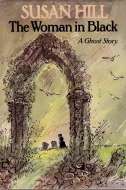The Woman in Black

A 1983 novel written by Susan Hill, with a 1989 Made for TV Movie adaptation and a (still-running) 1989 stage adaptation. The story centers on a young solicitor, Arthur Kipps, who goes to a small market town on the east coast of Britain to attend to the funeral of Mrs Alice Drablow, an elderly widow who lived alone in solitary Eel Marsh House. She lived in a house isolated on an isle that is inaccessible for most of the day when the causeway floods. Oh, and it is haunted by her sister and mother of her adopted son (who died in an accident while still very young) Jennet. Whenever she is seen, a child dies.
Kipps is left a nervous wreck and returns to London to his fiancée.
The stage play has a different slant, in order to keep the budget low and to be able to do it as a two-hander play, it is instead portrayed as an elderly Kipps employing an actor to help him get the story across to his family.
The stage play adaptation has now been going on for 20 years at the Fortune theater, making it the longest-running thriller in London's West End (at, co-incidentally, the West End's smallest theater). This play is a favourite of school drama trips, making sure the audience usually has a group of easily startled kids who will scream in all the right places...
In 2012, Hammer Films released a feature film version starring Daniel Radcliffe. Coincidentally, the 1989 version starred Radcliffe's onscreen father Adrian Rawlins.
- Apocalyptic Log: Jennet Humfrye's letters to Alice Drablow, which conclude on a note of dire Foreshadowing.
- Evil-Detecting Dog: Spider.
- Facial Horror: Arthur finds the Woman in Black's face creepier and creepier each time he sees it; at best, it looks near-skeletal.
- Foregone Conclusion: After all, we know at the beginning of the novel that Arthur was widowed in his early twenties.
- Ghostly Goals: Type B.
- Ghost Story: Obviously, but the novel opens with Arthur's family telling ghost stories on Christmas Eve.
- Hammer Horror: Bears all of the moodiness and foreboding of a Hammer Film. Appropriately, they are producing the Remake, which takes the atmosphere up to eleven.
- Haunted House: Eel Marsh.
- I See Dead People: In the novel, the ghost is visible only to Arthur.
- Jump Scare:
- All over the place in the stage play. Audiences regularly shriek out loud, and that's kind of the point.
- Used frequently and very effectively in the film version.
- Just Eat Gilligan: Kipps has to review all of Alice Drablow's documents, a task that will take several days at least. This apparently necessitates him staying in the creepy haunted house over several nights to do so...instead of, for example, reviewing said documents in the relative safety of the town.
- Ominous Fog
- Quicksand Sucks: Played straight.
- Stellar Name: Kipps' fiancée.
- Nightmare Fuel Station Attendant: The WIB, bordering on High Octane Nightmare Fuel. The face alone qualifies her for the post. She kills children whenever she appears, and takes a fiendish delight in using the deaths for revenge.
- In the theater version, she appears to the actor, who reveals that he has a wife and son, similarly to Kipps before they died. Kipps cannot see her. The play ends as the actor claps his hand to his mouth in horror, then runs offstage...
The theater version provides examples of:
- Bad Bad Acting: Kipps, until about halfway through the first scene in his story.
- Literary Agent Hypothesis: The actor being employed to take on Kipps' role and Kipps himself taking on the role of the people he encountered during the story.
- Person with the Clothing
- Reading the Stage Directions Out Loud: Older-Kipps.
- Stylistic Suck: Stage only, and lampshaded by the actor, referring to Kipps' manuscript of the event.